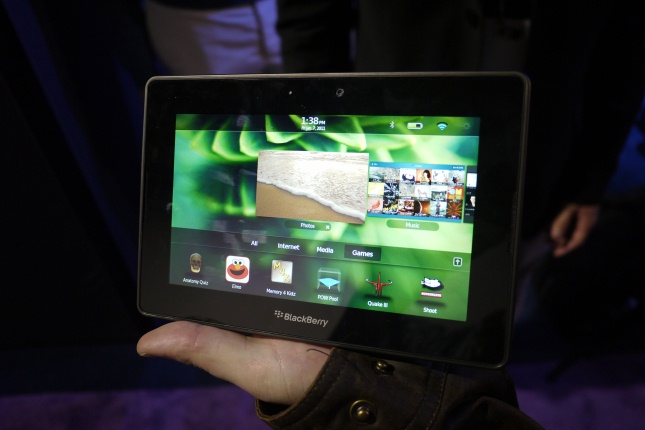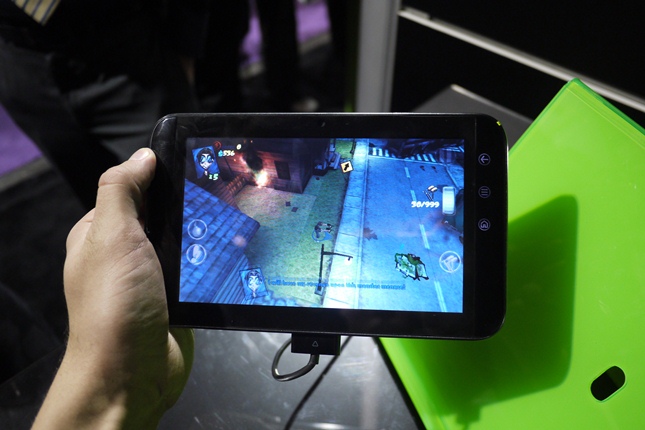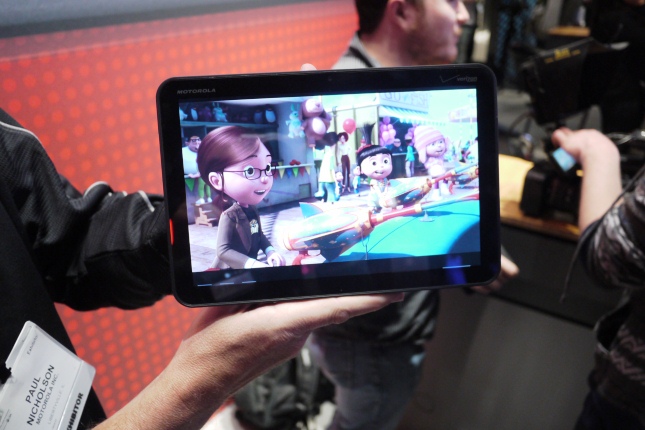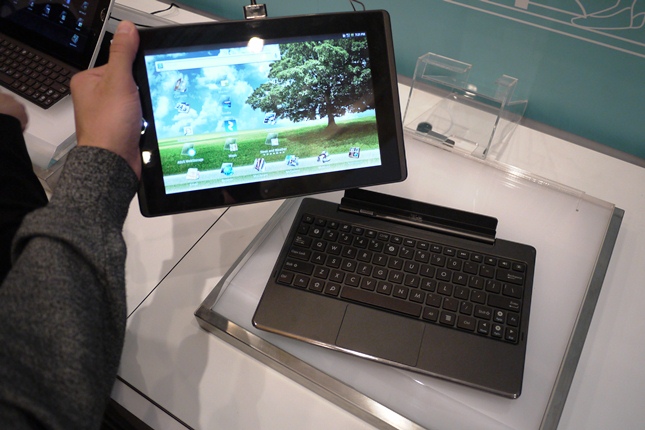Results of CES-2011
Nikolai Turubar, the chief editor of NOMOBILE.RU, talks about Android, two cores, bows and why CES 2011 resembled a pharmacy:
After the fabulous September IFA in Berlin, an equally bright CES exhibition in Las Vegas followed, finally convincing me that the time of techno fairs was back. And this is despite the fact that top brands refuse to participate in “hodgepodge”, increasingly organizing exhibitions on behalf of themselves. Kim Korshunov and I just knocked down, trying to have time to run around all the bright gadgets, and yet a couple of years ago we had to find them in the afternoon with fire!
If a year ago, the main leitmotif of CES was 3D-television, then in 2011 the main and undisputed trend was tablet computers. However, the delight of their number quickly passed: there were so many “pills” that on the second day of the exhibition I felt like in a pharmacy, and from the endless rows of identical tablets I was already beginning to feel nauseous - everything looks the same! And - a rare case - when in the “Chinatown”, the Chinese exhibition stands, it was not interesting to wander, because there, too, everything was in the tablets. Sadly recalled the time when the phones had many different formats - you walk between the Chinese ranks and guess: yeah, this phone “licked” from Nokia, and this looks like Motorola ... But the trends of time are (thanks, Apple!) That the main format The gadget is a screen with one hardware or four touch buttons and minor differences in the internal filling. Therefore, each tablet, at least slightly different from the standard, attracted increased attention. That turned out to be the one announced last year, but for the first time shown to the public the Blackberry Playbook - in my opinion, the main prima of the exhibition.
')

Blackberry playbook
Although outwardly the tablet itself did not go far away from its counterparts - a 7-inch display, a case of black and, unfortunately, glossy plastic ... this is where the common features end. There are no buttons at all - all control is carried out by touching the edges of the screen, which on closer inspection turned out to be as comfortable, as effective. But the most important thing is inside Android, which is not stuck in the teeth, and not even Blacberry OS, but the QNX real-time operating system, unique in its stability, which is used almost everywhere: from cars to airplanes. All running programs work in real time, which is very impressive. In addition, thanks to the Blackberry Bridge function, the tablet communicates via Bluetooth with the Blackberry smartphone and gets access to its messages and calendar: on the big screen you can do all the actions with letters and applications, and all of them are instantly synchronized with the phone.

Blackberry bridge
It seems that with proper marketing this tablet has a great future, especially in the USA, where Blackberry is a cult product. The overwhelming number of other tablets worked exclusively on Android with some glimpses (here, yes, quotes) tablets on Windows 7 - thus the brands “escorted” the “seven” from the tablet market, all such products are made for ticks and loyalty to a large partner Microsoft.
The exhibition was marked by a loud entry into the market of mobile platforms by Nvidia, which presented its dual-core processor for mobile devices Tegra 2 , optimized just for tablets and smartphones. It seems that the two cores are the next trend: the products on Tegra 2 were presented by several brands at once, interesting tablets turned out to be from Acer - this is 10-inch Picasso, and Dell - 7-inch Streak , also smartphones appeared, about which below.

Dell Streak 7
Only Samsung, which produces its own processors, was silent, but its dual-core Orion processor is apparently quite raw, so Koreans will use Tegra 2 solution in their gadgets for now. But at the exhibition, the Samsung Tab found itself in the laggard camp, although this gadget managed to collect its cream last year. We are waiting for a Korean response at the Mobile World Congress in Barcelona or a little later in Budapest at the Samsung CIS Forum.
As usual, the competition of marketers of companies was marked by “who has more”, but recently the products are measured not by the number of megapixels, revolutions of the clock frequency or gigabytes of internal memory, but by Android versions - who is older? According to this indicator, the undisputed leader of the exhibition was Motorola's UBEPLAYT - this is XOOM , formerly known as MotoPAD and “leaked” to the Network in December thanks to Google’s point sink.

Motorola xoom
However, the working system on Android 3.0 was not shown to the public: the OS was a set of videos uploaded to XOOM, each of which showed the features of various interface elements of the new version of the operating system. But Motorola was chosen by Google as a locomotive - other brands didn’t get such happiness, because the oldest version of Android was 2.3. The third version has the code name Honeycomb, designed specifically for large devices - tablets, among other things, it improved multitasking, a spectacular 3D menu and a new Homescreen, changed the notification system and improved the browser.
All the major smartphones of the exhibition are “small tablets”, all the same touchless Android-backgrounds, they all got the HDMI output and the photo module improved. Again, Motorola distinguished itself by showing the world's most powerful Atrix 4G smartphone, which was also the first to receive a unique qHD screen resolution (960x540 pixels).

Motorola Atrix 4G
In general, the dimensions of the smartphone displays have crossed the dangerous 4-inch border and again erased the line between computers and phones, and again it became unclear how to call such devices - Nvidia offered the superphone option, which is unlikely to get accustomed. The most balanced and attractive superphone of the exhibition, I consider the Sony Ericsson Arc - the new flagship of the Xperia line, which turned out to be very thin and elegant. Perhaps this is the most beautiful gadget ever made on Android, I liked the design and the material from which it was made - I even confused it with metal, although the back cover of the device is painted with metallized paint using vacuum technology. The phone has a 4.2-inch screen, runs on Android 2.3, and has the most powerful camera among all Android backgrounds, this is a 8.1-megapixel module with a Sony Exmor R matrix, autofocus and the ability to record HD video. And, despite the fact that the basis of the phone is not Tegra2, it has very good chances to become a bestseller in Russia provided the right price and fast delivery times, which Sony Ericsson is not always happy with.
LG showed three powerful smartphones: a slim Optimus Black (9.2 mm) with a new type of Nova screens, a dual-core Optimus 2x on Tegra 2 and a phone for 4G LTE networks with a loud name Revolution . It seems that 2011 has all chances to become the year of the “most thin smartphones”. Samsung also rolled out a smartphone on Android 2.2 with 4G support, and its giant 4.5-inch display was also made using the new SuperAMOLED Plus technology - with greater contrast and protection against glare. The Taiwanese HTC, despite the fact that most of the announcements were reserved before the Mobile World Congress in Barcelona, still showed three 4G smartphones on Android 2.2 here: QWERTY Evo Shift 4G slider, 4.3-inch ThunderBolt with 8 megapixel camera and HTC Inspire 4G with the same display. However, all the phones of this trio will not appear on the Russian market, they are designed for American operators.
CES exhibition finally gave rise to a new type of gadgets - transformers, consisting of tablet and keyboard parts. With a slight stretch to this class can even be attributed to the docking station Laptop Dock, which is offered as an accessory to the already mentioned Motorola Atrix smartphone. The docking station is designed as an 11-inch laptop, which, however, does not have its own memory and operating system, but uses the power of a smartphone inserted into the connector. The concept is not new - for several years now, Celiocorp has been offering similar products - these are laptop-like gadgets for working with Windows-based smartphones and Blackberry phones. I consider the Lenovo U1 , aka LePad, to be the classic representative and pioneer of the section of transformers. Externally, the gadget looks like a regular keyboard 10-inch laptop on Windows 7, but with a flick of the wrist, the upper half, that is, the screen, comes out and turns into an Android 2.2 tablet. We can assume that Lenovo invented this format - U1 was shown at last year’s CES, but then the tablet worked on the “bare” Linux. The gadget is successfully sold in China, and you can buy a tablet separately, without the keyboard part. This concept is convenient: for example, you take a tablet to a meeting, and at work or at home you insert it into the docking station, it is also more convenient to watch movies on the plane with a tablet - the keyboard is not needed here.
The trend was supported by Asus, who proposed a similar Eee Pad Transformer , but already on Nvidia Tegra 2. Intermediate compromise solution - tablet sliders, which showed the same Asus (she, however, turned out to be quite a bit clumsy Eee Pad Slider) and Samsung with its chic Samsung Sliding PC 7 with blue keyboard.

Asus eee pad transformer
And very poor relatives at this exhibition looked laptops, it was clearly not their holiday. And this is despite the fact that laptops on Intel Core processors of the second generation were first shown at CES, so all notebook brands dutifully transfer their laptops to a new platform. In general, there were interesting products to take at least Samsung's super-slim line of Series 9 laptops, which got involved in a battle with its MacBook Air in its territory. I also liked the stylized U260 from Lenovo , it is also the top five primarily for the design: the laptop looks like a thin book and is very pleasant to the touch. I consider the best concept CES to be a 7-inch Switchblade gaming laptop with a multi-touch display and keyboard, which changes to the context of the game (something similar was realized by Artemy Lebedev in his Optimus Maximus). Of course, there were a lot of interesting products from other categories: Sony Bloggie 3D camera and JVC Everio GS-TD1 , there was a Polaroid comeback (camera + mini printer in one case), there were a lot of “right” monoblocks like Lenovo IdeaCentre A320 and computer accessories like a mouse Microsoft Touch Mouse , understanding multi-touch gestures and the semicircular keyboard Smartfish Engage Keyboard ... But these are the words of another song.
After the fabulous September IFA in Berlin, an equally bright CES exhibition in Las Vegas followed, finally convincing me that the time of techno fairs was back. And this is despite the fact that top brands refuse to participate in “hodgepodge”, increasingly organizing exhibitions on behalf of themselves. Kim Korshunov and I just knocked down, trying to have time to run around all the bright gadgets, and yet a couple of years ago we had to find them in the afternoon with fire!
Tablet redistribution
If a year ago, the main leitmotif of CES was 3D-television, then in 2011 the main and undisputed trend was tablet computers. However, the delight of their number quickly passed: there were so many “pills” that on the second day of the exhibition I felt like in a pharmacy, and from the endless rows of identical tablets I was already beginning to feel nauseous - everything looks the same! And - a rare case - when in the “Chinatown”, the Chinese exhibition stands, it was not interesting to wander, because there, too, everything was in the tablets. Sadly recalled the time when the phones had many different formats - you walk between the Chinese ranks and guess: yeah, this phone “licked” from Nokia, and this looks like Motorola ... But the trends of time are (thanks, Apple!) That the main format The gadget is a screen with one hardware or four touch buttons and minor differences in the internal filling. Therefore, each tablet, at least slightly different from the standard, attracted increased attention. That turned out to be the one announced last year, but for the first time shown to the public the Blackberry Playbook - in my opinion, the main prima of the exhibition.
')

Blackberry playbook
Although outwardly the tablet itself did not go far away from its counterparts - a 7-inch display, a case of black and, unfortunately, glossy plastic ... this is where the common features end. There are no buttons at all - all control is carried out by touching the edges of the screen, which on closer inspection turned out to be as comfortable, as effective. But the most important thing is inside Android, which is not stuck in the teeth, and not even Blacberry OS, but the QNX real-time operating system, unique in its stability, which is used almost everywhere: from cars to airplanes. All running programs work in real time, which is very impressive. In addition, thanks to the Blackberry Bridge function, the tablet communicates via Bluetooth with the Blackberry smartphone and gets access to its messages and calendar: on the big screen you can do all the actions with letters and applications, and all of them are instantly synchronized with the phone.

Blackberry bridge
It seems that with proper marketing this tablet has a great future, especially in the USA, where Blackberry is a cult product. The overwhelming number of other tablets worked exclusively on Android with some glimpses (here, yes, quotes) tablets on Windows 7 - thus the brands “escorted” the “seven” from the tablet market, all such products are made for ticks and loyalty to a large partner Microsoft.
Kernels - pure emerald?
The exhibition was marked by a loud entry into the market of mobile platforms by Nvidia, which presented its dual-core processor for mobile devices Tegra 2 , optimized just for tablets and smartphones. It seems that the two cores are the next trend: the products on Tegra 2 were presented by several brands at once, interesting tablets turned out to be from Acer - this is 10-inch Picasso, and Dell - 7-inch Streak , also smartphones appeared, about which below.

Dell Streak 7
Only Samsung, which produces its own processors, was silent, but its dual-core Orion processor is apparently quite raw, so Koreans will use Tegra 2 solution in their gadgets for now. But at the exhibition, the Samsung Tab found itself in the laggard camp, although this gadget managed to collect its cream last year. We are waiting for a Korean response at the Mobile World Congress in Barcelona or a little later in Budapest at the Samsung CIS Forum.
Android Third
As usual, the competition of marketers of companies was marked by “who has more”, but recently the products are measured not by the number of megapixels, revolutions of the clock frequency or gigabytes of internal memory, but by Android versions - who is older? According to this indicator, the undisputed leader of the exhibition was Motorola's UBEPLAYT - this is XOOM , formerly known as MotoPAD and “leaked” to the Network in December thanks to Google’s point sink.

Motorola xoom
However, the working system on Android 3.0 was not shown to the public: the OS was a set of videos uploaded to XOOM, each of which showed the features of various interface elements of the new version of the operating system. But Motorola was chosen by Google as a locomotive - other brands didn’t get such happiness, because the oldest version of Android was 2.3. The third version has the code name Honeycomb, designed specifically for large devices - tablets, among other things, it improved multitasking, a spectacular 3D menu and a new Homescreen, changed the notification system and improved the browser.
After the word "shovel"
All the major smartphones of the exhibition are “small tablets”, all the same touchless Android-backgrounds, they all got the HDMI output and the photo module improved. Again, Motorola distinguished itself by showing the world's most powerful Atrix 4G smartphone, which was also the first to receive a unique qHD screen resolution (960x540 pixels).

Motorola Atrix 4G
In general, the dimensions of the smartphone displays have crossed the dangerous 4-inch border and again erased the line between computers and phones, and again it became unclear how to call such devices - Nvidia offered the superphone option, which is unlikely to get accustomed. The most balanced and attractive superphone of the exhibition, I consider the Sony Ericsson Arc - the new flagship of the Xperia line, which turned out to be very thin and elegant. Perhaps this is the most beautiful gadget ever made on Android, I liked the design and the material from which it was made - I even confused it with metal, although the back cover of the device is painted with metallized paint using vacuum technology. The phone has a 4.2-inch screen, runs on Android 2.3, and has the most powerful camera among all Android backgrounds, this is a 8.1-megapixel module with a Sony Exmor R matrix, autofocus and the ability to record HD video. And, despite the fact that the basis of the phone is not Tegra2, it has very good chances to become a bestseller in Russia provided the right price and fast delivery times, which Sony Ericsson is not always happy with.
LG showed three powerful smartphones: a slim Optimus Black (9.2 mm) with a new type of Nova screens, a dual-core Optimus 2x on Tegra 2 and a phone for 4G LTE networks with a loud name Revolution . It seems that 2011 has all chances to become the year of the “most thin smartphones”. Samsung also rolled out a smartphone on Android 2.2 with 4G support, and its giant 4.5-inch display was also made using the new SuperAMOLED Plus technology - with greater contrast and protection against glare. The Taiwanese HTC, despite the fact that most of the announcements were reserved before the Mobile World Congress in Barcelona, still showed three 4G smartphones on Android 2.2 here: QWERTY Evo Shift 4G slider, 4.3-inch ThunderBolt with 8 megapixel camera and HTC Inspire 4G with the same display. However, all the phones of this trio will not appear on the Russian market, they are designed for American operators.
And side bow
CES exhibition finally gave rise to a new type of gadgets - transformers, consisting of tablet and keyboard parts. With a slight stretch to this class can even be attributed to the docking station Laptop Dock, which is offered as an accessory to the already mentioned Motorola Atrix smartphone. The docking station is designed as an 11-inch laptop, which, however, does not have its own memory and operating system, but uses the power of a smartphone inserted into the connector. The concept is not new - for several years now, Celiocorp has been offering similar products - these are laptop-like gadgets for working with Windows-based smartphones and Blackberry phones. I consider the Lenovo U1 , aka LePad, to be the classic representative and pioneer of the section of transformers. Externally, the gadget looks like a regular keyboard 10-inch laptop on Windows 7, but with a flick of the wrist, the upper half, that is, the screen, comes out and turns into an Android 2.2 tablet. We can assume that Lenovo invented this format - U1 was shown at last year’s CES, but then the tablet worked on the “bare” Linux. The gadget is successfully sold in China, and you can buy a tablet separately, without the keyboard part. This concept is convenient: for example, you take a tablet to a meeting, and at work or at home you insert it into the docking station, it is also more convenient to watch movies on the plane with a tablet - the keyboard is not needed here.
The trend was supported by Asus, who proposed a similar Eee Pad Transformer , but already on Nvidia Tegra 2. Intermediate compromise solution - tablet sliders, which showed the same Asus (she, however, turned out to be quite a bit clumsy Eee Pad Slider) and Samsung with its chic Samsung Sliding PC 7 with blue keyboard.

Asus eee pad transformer
Someone else's wedding
And very poor relatives at this exhibition looked laptops, it was clearly not their holiday. And this is despite the fact that laptops on Intel Core processors of the second generation were first shown at CES, so all notebook brands dutifully transfer their laptops to a new platform. In general, there were interesting products to take at least Samsung's super-slim line of Series 9 laptops, which got involved in a battle with its MacBook Air in its territory. I also liked the stylized U260 from Lenovo , it is also the top five primarily for the design: the laptop looks like a thin book and is very pleasant to the touch. I consider the best concept CES to be a 7-inch Switchblade gaming laptop with a multi-touch display and keyboard, which changes to the context of the game (something similar was realized by Artemy Lebedev in his Optimus Maximus). Of course, there were a lot of interesting products from other categories: Sony Bloggie 3D camera and JVC Everio GS-TD1 , there was a Polaroid comeback (camera + mini printer in one case), there were a lot of “right” monoblocks like Lenovo IdeaCentre A320 and computer accessories like a mouse Microsoft Touch Mouse , understanding multi-touch gestures and the semicircular keyboard Smartfish Engage Keyboard ... But these are the words of another song.
Source: https://habr.com/ru/post/112064/
All Articles